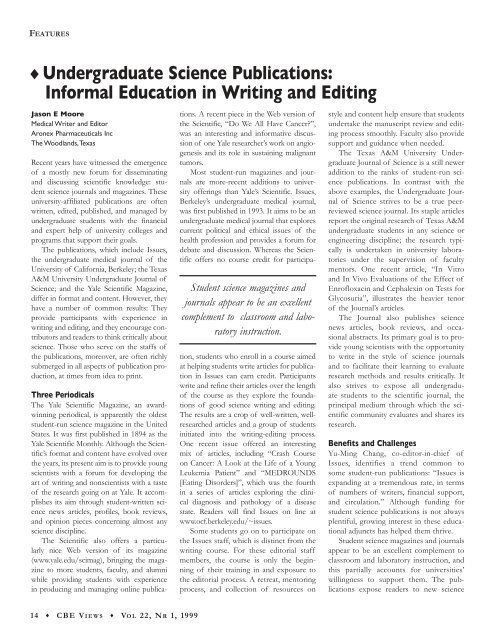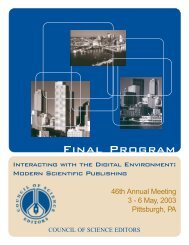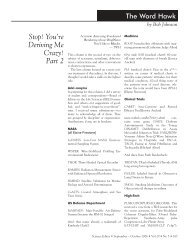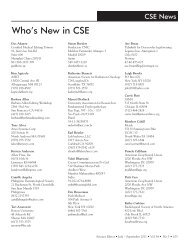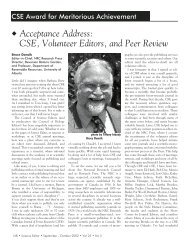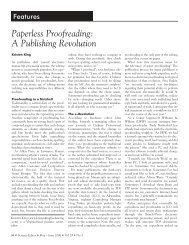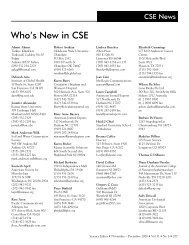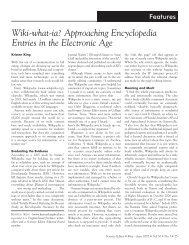Informal Education in Writing and Editing - Council of Science Editors
Informal Education in Writing and Editing - Council of Science Editors
Informal Education in Writing and Editing - Council of Science Editors
Create successful ePaper yourself
Turn your PDF publications into a flip-book with our unique Google optimized e-Paper software.
FEATURES<br />
◆ Undergraduate <strong>Science</strong> Publications:<br />
<strong>Informal</strong> <strong>Education</strong> <strong>in</strong> Writ<strong>in</strong>g <strong>and</strong> Edit<strong>in</strong>g<br />
Jason E Moore<br />
Medical Writer <strong>and</strong> Editor<br />
Aronex Pharmaceuticals Inc<br />
The Woodl<strong>and</strong>s, Texas<br />
Recent years have witnessed the emergence<br />
<strong>of</strong> a mostly new forum for dissem<strong>in</strong>at<strong>in</strong>g<br />
<strong>and</strong> discuss<strong>in</strong>g scientific knowledge: student<br />
science journals <strong>and</strong> magaz<strong>in</strong>es. These<br />
university-affiliated publications are <strong>of</strong>ten<br />
written, edited, published, <strong>and</strong> managed by<br />
undergraduate students with the f<strong>in</strong>ancial<br />
<strong>and</strong> expert help <strong>of</strong> university colleges <strong>and</strong><br />
programs that support their goals.<br />
The publications, which <strong>in</strong>clude Issues,<br />
the undergraduate medical journal <strong>of</strong> the<br />
University <strong>of</strong> California, Berkeley; the Texas<br />
A&M University Undergraduate Journal <strong>of</strong><br />
<strong>Science</strong>; <strong>and</strong> the Yale Scientific Magaz<strong>in</strong>e,<br />
differ <strong>in</strong> format <strong>and</strong> content. However, they<br />
have a number <strong>of</strong> common results: They<br />
provide participants with experience <strong>in</strong><br />
writ<strong>in</strong>g <strong>and</strong> edit<strong>in</strong>g, <strong>and</strong> they encourage contributors<br />
<strong>and</strong> readers to th<strong>in</strong>k critically about<br />
science. Those who serve on the staffs <strong>of</strong><br />
the publications, moreover, are <strong>of</strong>ten richly<br />
submerged <strong>in</strong> all aspects <strong>of</strong> publication production,<br />
at times from idea to pr<strong>in</strong>t.<br />
Student science magaz<strong>in</strong>es <strong>and</strong><br />
journals appear to be an excellent<br />
complement to classroom <strong>and</strong> laboratory<br />
<strong>in</strong>struction.<br />
Three Periodicals<br />
The Yale Scientific Magaz<strong>in</strong>e, an awardw<strong>in</strong>n<strong>in</strong>g<br />
periodical, is apparently the oldest<br />
student-run science magaz<strong>in</strong>e <strong>in</strong> the United<br />
States. It was first published <strong>in</strong> 1894 as the<br />
Yale Scientific Monthly. Although the Scientific’s<br />
format <strong>and</strong> content have evolved over<br />
the years, its present aim is to provide young<br />
scientists with a forum for develop<strong>in</strong>g the<br />
art <strong>of</strong> writ<strong>in</strong>g <strong>and</strong> nonscientists with a taste<br />
<strong>of</strong> the research go<strong>in</strong>g on at Yale. It accomplishes<br />
its aim through student-written science<br />
news articles, pr<strong>of</strong>iles, book reviews,<br />
<strong>and</strong> op<strong>in</strong>ion pieces concern<strong>in</strong>g almost any<br />
science discipl<strong>in</strong>e.<br />
The Scientific also <strong>of</strong>fers a particularly<br />
nice Web version <strong>of</strong> its magaz<strong>in</strong>e<br />
(www.yale.edu/scimag), br<strong>in</strong>g<strong>in</strong>g the magaz<strong>in</strong>e<br />
to more students, faculty, <strong>and</strong> alumni<br />
while provid<strong>in</strong>g students with experience<br />
<strong>in</strong> produc<strong>in</strong>g <strong>and</strong> manag<strong>in</strong>g onl<strong>in</strong>e publications.<br />
A recent piece <strong>in</strong> the Web version <strong>of</strong><br />
the Scientific, “Do We All Have Cancer?”,<br />
was an <strong>in</strong>terest<strong>in</strong>g <strong>and</strong> <strong>in</strong>formative discussion<br />
<strong>of</strong> one Yale researcher’s work on angiogenesis<br />
<strong>and</strong> its role <strong>in</strong> susta<strong>in</strong><strong>in</strong>g malignant<br />
tumors.<br />
Most student-run magaz<strong>in</strong>es <strong>and</strong> journals<br />
are more-recent additions to university<br />
<strong>of</strong>fer<strong>in</strong>gs than Yale’s Scientific. Issues,<br />
Berkeley’s undergraduate medical journal,<br />
was first published <strong>in</strong> 1993. It aims to be an<br />
undergraduate medical journal that explores<br />
current political <strong>and</strong> ethical issues <strong>of</strong> the<br />
health pr<strong>of</strong>ession <strong>and</strong> provides a forum for<br />
debate <strong>and</strong> discussion. Whereas the Scientific<br />
<strong>of</strong>fers no course credit for participation,<br />
students who enroll <strong>in</strong> a course aimed<br />
at help<strong>in</strong>g students write articles for publication<br />
<strong>in</strong> Issues can earn credit. Participants<br />
write <strong>and</strong> ref<strong>in</strong>e their articles over the length<br />
<strong>of</strong> the course as they explore the foundations<br />
<strong>of</strong> good science writ<strong>in</strong>g <strong>and</strong> edit<strong>in</strong>g.<br />
The results are a crop <strong>of</strong> well-written, wellresearched<br />
articles <strong>and</strong> a group <strong>of</strong> students<br />
<strong>in</strong>itiated <strong>in</strong>to the writ<strong>in</strong>g-edit<strong>in</strong>g process.<br />
One recent issue <strong>of</strong>fered an <strong>in</strong>terest<strong>in</strong>g<br />
mix <strong>of</strong> articles, <strong>in</strong>clud<strong>in</strong>g “Crash Course<br />
on Cancer: A Look at the Life <strong>of</strong> a Young<br />
Leukemia Patient” <strong>and</strong> “MEDROUNDS<br />
[Eat<strong>in</strong>g Disorders]”, which was the fourth<br />
<strong>in</strong> a series <strong>of</strong> articles explor<strong>in</strong>g the cl<strong>in</strong>ical<br />
diagnosis <strong>and</strong> pathology <strong>of</strong> a disease<br />
state. Readers will f<strong>in</strong>d Issues on l<strong>in</strong>e at<br />
www.ocf.berkeley.edu/~issues.<br />
Some students go on to participate on<br />
the Issues staff, which is dist<strong>in</strong>ct from the<br />
writ<strong>in</strong>g course. For these editorial staff<br />
members, the course is only the beg<strong>in</strong>n<strong>in</strong>g<br />
<strong>of</strong> their tra<strong>in</strong><strong>in</strong>g <strong>in</strong> <strong>and</strong> exposure to<br />
the editorial process. A retreat, mentor<strong>in</strong>g<br />
process, <strong>and</strong> collection <strong>of</strong> resources on<br />
style <strong>and</strong> content help ensure that students<br />
undertake the manuscript review <strong>and</strong> edit<strong>in</strong>g<br />
process smoothly. Faculty also provide<br />
support <strong>and</strong> guidance when needed.<br />
The Texas A&M University Undergraduate<br />
Journal <strong>of</strong> <strong>Science</strong> is a still newer<br />
addition to the ranks <strong>of</strong> student-run science<br />
publications. In contrast with the<br />
above examples, the Undergraduate Journal<br />
<strong>of</strong> <strong>Science</strong> strives to be a true peerreviewed<br />
science journal. Its staple articles<br />
report the orig<strong>in</strong>al research <strong>of</strong> Texas A&M<br />
undergraduate students <strong>in</strong> any science or<br />
eng<strong>in</strong>eer<strong>in</strong>g discipl<strong>in</strong>e; the research typically<br />
is undertaken <strong>in</strong> university laboratories<br />
under the supervision <strong>of</strong> faculty<br />
mentors. One recent article, “In Vitro<br />
<strong>and</strong> In Vivo Evaluations <strong>of</strong> the Effect <strong>of</strong><br />
Enr<strong>of</strong>loxac<strong>in</strong> <strong>and</strong> Cephalex<strong>in</strong> on Tests for<br />
Glycosuria”, illustrates the heavier tenor<br />
<strong>of</strong> the Journal’s articles.<br />
The Journal also publishes science<br />
news articles, book reviews, <strong>and</strong> occasional<br />
abstracts. Its primary goal is to provide<br />
young scientists with the opportunity<br />
to write <strong>in</strong> the style <strong>of</strong> science journals<br />
<strong>and</strong> to facilitate their learn<strong>in</strong>g to evaluate<br />
research methods <strong>and</strong> results critically. It<br />
also strives to expose all undergraduate<br />
students to the scientific journal, the<br />
pr<strong>in</strong>cipal medium through which the scientific<br />
community evaluates <strong>and</strong> shares its<br />
research.<br />
Benefits <strong>and</strong> Challenges<br />
Yu-M<strong>in</strong>g Chang, co-editor-<strong>in</strong>-chief <strong>of</strong><br />
Issues, identifies a trend common to<br />
some student-run publications: “Issues is<br />
exp<strong>and</strong><strong>in</strong>g at a tremendous rate, <strong>in</strong> terms<br />
<strong>of</strong> numbers <strong>of</strong> writers, f<strong>in</strong>ancial support,<br />
<strong>and</strong> circulation.” Although fund<strong>in</strong>g for<br />
student science publications is not always<br />
plentiful, grow<strong>in</strong>g <strong>in</strong>terest <strong>in</strong> these educational<br />
adjuncts has helped them thrive.<br />
Student science magaz<strong>in</strong>es <strong>and</strong> journals<br />
appear to be an excellent complement to<br />
classroom <strong>and</strong> laboratory <strong>in</strong>struction, <strong>and</strong><br />
this partially accounts for universities’<br />
will<strong>in</strong>gness to support them. The publications<br />
expose readers to new science<br />
14 ♦ CBE VIEWS ♦ VOL 22, NR 1, 1999
FEATURES<br />
developments <strong>and</strong> stimulate thought <strong>and</strong><br />
discussion <strong>of</strong> current issues <strong>in</strong> science.<br />
Moreover, authors are <strong>in</strong>troduced, <strong>of</strong>ten<br />
for the first time, to the process <strong>of</strong> writ<strong>in</strong>g<br />
about science, either through journalistic<br />
writ<strong>in</strong>g or through the communication<br />
<strong>of</strong> orig<strong>in</strong>al research. F<strong>in</strong>ally, the student<br />
staff responsible for review<strong>in</strong>g, edit<strong>in</strong>g,<br />
<strong>and</strong> publish<strong>in</strong>g the magaz<strong>in</strong>es <strong>and</strong> journals<br />
f<strong>in</strong>d opportunities to develop skills <strong>in</strong> the<br />
critical evaluation <strong>of</strong> science <strong>and</strong> to obta<strong>in</strong><br />
managerial <strong>and</strong> editorial experience.<br />
One recurr<strong>in</strong>g theme encountered <strong>in</strong><br />
discussions with these publications’ editors<br />
is the ambitious nature <strong>of</strong> ask<strong>in</strong>g<br />
undergraduate students to undertake what<br />
is at times the daunt<strong>in</strong>g task <strong>of</strong> produc<strong>in</strong>g<br />
periodicals. As with the production <strong>of</strong> any<br />
serial publication, the logistics are complex<br />
<strong>and</strong> time-consum<strong>in</strong>g <strong>and</strong> present substantial<br />
challenges to students who have never<br />
been exposed to science journalism or<br />
technical writ<strong>in</strong>g, edit<strong>in</strong>g, or publish<strong>in</strong>g.<br />
F<strong>in</strong>d<strong>in</strong>g adequate manpower to h<strong>and</strong>le<br />
all aspects <strong>of</strong> writ<strong>in</strong>g, review, edit<strong>in</strong>g, <strong>and</strong><br />
publish<strong>in</strong>g is a challenge to all.<br />
Other challenges, which are nearly<br />
endemic <strong>in</strong> scholarly journals, are also<br />
experienced. Yu-M<strong>in</strong>g Chang articulates a<br />
situation familiar to virtually all editors <strong>and</strong><br />
managers <strong>of</strong> these publications, whether<br />
novice or seasoned: “A challenge that we<br />
face <strong>in</strong> the edit<strong>in</strong>g/review process is gett<strong>in</strong>g<br />
the writers to revise their articles . . . <strong>in</strong> a<br />
timely fashion.” What editor hasn’t heard<br />
that before?!<br />
At the same time, a nearly universal<br />
benefit is voiced by the participants:<br />
Despite the substantial work <strong>in</strong>volved,<br />
there is great satisfaction <strong>in</strong> see<strong>in</strong>g the<br />
journal or magaz<strong>in</strong>e published. It was certa<strong>in</strong>ly<br />
a thrill<strong>in</strong>g moment when I saw the<br />
first issue <strong>of</strong> the Undergraduate Journal <strong>of</strong><br />
<strong>Science</strong> come <strong>of</strong>f the press. Participants<br />
also agree that they learned not only about<br />
narrow scientific topics, but also about<br />
how science is done <strong>and</strong> how its fruits are<br />
evaluated <strong>and</strong> presented to the public.<br />
My discussions with other student science-publication<br />
editors suggest that most<br />
students do not view participation as a<br />
conduit to a career as a writer or editor,<br />
although some budd<strong>in</strong>g science writers are<br />
to be found among them. Most participants<br />
seem to be serious students <strong>of</strong> science<br />
who wish to learn more about their<br />
own academic discipl<strong>in</strong>es.<br />
Participants nonetheless learn that a<br />
pr<strong>of</strong>ession <strong>of</strong> editors <strong>and</strong> writers exists. A<br />
few do <strong>in</strong>deed learn that a career <strong>in</strong> writ<strong>in</strong>g<br />
<strong>and</strong> edit<strong>in</strong>g may be for them. I, <strong>in</strong> fact,<br />
had an “Aha!” experience as editor <strong>of</strong> the<br />
Undergraduate Journal <strong>of</strong> <strong>Science</strong>. Edit<strong>in</strong>g<br />
<strong>and</strong> manag<strong>in</strong>g the publication provided<br />
me extraord<strong>in</strong>ary gratification <strong>and</strong> paved<br />
the way to a fasc<strong>in</strong>at<strong>in</strong>g pr<strong>of</strong>essional life<br />
as an editor <strong>and</strong> writer. Perhaps others<br />
will f<strong>in</strong>d their way to the pr<strong>of</strong>ession <strong>of</strong><br />
scholarly writ<strong>in</strong>g <strong>and</strong> edit<strong>in</strong>g through<br />
student science magaz<strong>in</strong>es <strong>and</strong> journals.<br />
Those already <strong>in</strong> the fold can look on<br />
with approval as students make worthwhile<br />
<strong>in</strong>vestments <strong>of</strong> time, <strong>in</strong>terest, <strong>and</strong><br />
enthusiasm <strong>in</strong> science writ<strong>in</strong>g <strong>and</strong> edit<strong>in</strong>g<br />
a process that we know to be worthwhile<br />
<strong>and</strong> mean<strong>in</strong>gful.<br />
What’s New<br />
● Do you have a new job?<br />
● Did you w<strong>in</strong> a prize?<br />
● Did you receive an honor?<br />
● Did your book just get published?<br />
● Did you receive a degree or certificate?<br />
● Did you recently retire?<br />
If you have someth<strong>in</strong>g new <strong>in</strong> your pr<strong>of</strong>essional life, we <strong>in</strong>vite you to share your news<br />
with the readers <strong>of</strong> CBE Views. Describe your news <strong>in</strong> 50 to 100 words <strong>and</strong> send to<br />
Barbara Gastel, Editor, CBE Views, Department <strong>of</strong> Journalism, 230 Reed McDonald<br />
Build<strong>in</strong>g, Texas A&M University, College Station TX 77843-4111; fax 409-845-5408; e-<br />
mail b-gastel@tamu.edu.<br />
Discipl<strong>in</strong>e <strong>and</strong> tra<strong>in</strong><strong>in</strong>g <strong>in</strong><br />
writ<strong>in</strong>g is probably the<br />
best tra<strong>in</strong><strong>in</strong>g there is <strong>in</strong><br />
reason<strong>in</strong>g.<br />
—WIB Beveridge<br />
The Art <strong>of</strong> Scientific<br />
Investigation<br />
CBE VIEWS ♦ VOL 22, NR 1, 1999 ♦ 15


